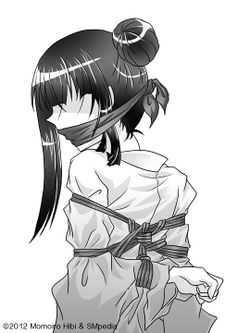Difference between revisions of "Gote takatekote"
| Line 34: | Line 34: | ||
'''USAGE2''': When '''Takate''' is interrupted as high position, the wrists must be at high position. In this case, [[Gote Shibari]] (or [[Ushirote Shibari]]) is used to represent the status in which the wrists are no in high position. | '''USAGE2''': When '''Takate''' is interrupted as high position, the wrists must be at high position. In this case, [[Gote Shibari]] (or [[Ushirote Shibari]]) is used to represent the status in which the wrists are no in high position. | ||
| − | '''USAGE3''': For most shibari in ancient [[Hojojutsu]], '''Takate''', '''Kote''' and '''Neck''' are key positions that must be tied. In this sense, they can be belonged to [[Gote Takatekote]] (see for instance, [http://nawa-art.com/backnumber/1950/195304/01/006.html Tsujimura's early shibari]). They don't necessarily contain chest harness ropes. However, it is not clear whether the word "Gote Takatekote" existed in ancient ages or not (probably not). It could be a new word invented in | + | '''USAGE3''': For most shibari in ancient [[Hojojutsu]], '''Takate''', '''Kote''' and '''Neck''' are key positions that must be tied. In this sense, they can be belonged to [[Gote Takatekote]] (see for instance, [http://nawa-art.com/backnumber/1950/195304/01/006.html Tsujimura's early shibari]). They don't necessarily contain chest harness ropes. However, it is not clear whether the word "Gote Takatekote" existed in ancient ages or not (probably not). It could be a new word invented in 50's - 70's. The word "Takatekote" can be seen (at least) in the writing on 1923, but we are not sure whether it represents [[Hojojutsu]] style or modern style. Modern style Shibari with chest harness appeared in arts on 1888 (Meiji era). It is highly possible that people in this ages enjoyed modern style [[Gote Takatekote]] in Kabuki plays (it is not clear that how it was called, though). Police in Edo era (17c ー19c) didn't use chest harness (with limited exemptions). |
==Gote Takatekote in magazines== | ==Gote Takatekote in magazines== | ||
Revision as of 04:27, 7 July 2012
Contents
Summary
One of the cardinal Shibari in modern Japanese Kinbaku. It has many alternative names including Takatekote (高手小手) and Gote Shibari (後手縛り). It also has more than one Yomikata, that is, Gote Takatekote, Ushirote Takatekote and Ushirode Takatekote.
Kanji
後手高手小手 (Japanese)
Alternative yomi
- Gote Takategote
- Ushirode Takatekote
- Ushirode Takategote
- Ushirote Takatekote
- Ushirote Takategote
Alternative names
Box tie, Chest harness, Gote Shibari (後手縛り), Takatekote (高手小手), Ushiro Takatekote (後高手小手), Ushiro Takatekote (後ろ高手小手), Ushiro Takatekote Shibari (後高手小手縛り), Ushirote Takatekote (後ろ手高手小手), Ushiro Kote Shibari (後小手縛り), Ushirode Sibari or Ushirote Shibari (後ろ手縛り), Gote Munenawa Shibari (後手胸縄縛り), Kotetaka (小手高), Takakote (高小手), Takatekote Shibari (高手小手縛り),
Analyses
Gote means the status that wrists are in one's back. Takate is old word standing the portion of upper arm. This word can be also interrupted to represent high position of arms. Kote means a wrist.
USAGE1: Shibari that binds wrists in one's back, and rope is laid upper and blow of breast where upper arms are fixed (see figure). The wrists are not necessary in high position.
USAGE2: When Takate is interrupted as high position, the wrists must be at high position. In this case, Gote Shibari (or Ushirote Shibari) is used to represent the status in which the wrists are no in high position.
USAGE3: For most shibari in ancient Hojojutsu, Takate, Kote and Neck are key positions that must be tied. In this sense, they can be belonged to Gote Takatekote (see for instance, Tsujimura's early shibari). They don't necessarily contain chest harness ropes. However, it is not clear whether the word "Gote Takatekote" existed in ancient ages or not (probably not). It could be a new word invented in 50's - 70's. The word "Takatekote" can be seen (at least) in the writing on 1923, but we are not sure whether it represents Hojojutsu style or modern style. Modern style Shibari with chest harness appeared in arts on 1888 (Meiji era). It is highly possible that people in this ages enjoyed modern style Gote Takatekote in Kabuki plays (it is not clear that how it was called, though). Police in Edo era (17c ー19c) didn't use chest harness (with limited exemptions).
Gote Takatekote in magazines
- Takashi Tsujimura・Tetsuzo Tsukamoto, "On the beauty of Kinbaku in Gote Takatekote", Kitan Club1953.4, Article
- Koji Sugihara, "Takatekote", Kitan Club1954.4, Photo
- Tetsuzo Tsukamoto, "How to take Kinbaku pictures: examples of Gote Takatekote", Kitan Club1961年.9, Article
- Tetsuzo Tsukamoto,『"How to take Kinbaku pictures: examples of kubinawa and Goteshibari", Kitan Club1962.4, Article
- Unknown, "Gote Takatekote with black nawa and a bar", Kitan Club1964.2, Photo
Gote Takatekote in art works
- 1888, Eitaku Kobayashi.
- 1924, Sengai Igawa
- 1947, Sentaro Iwata
- 1948, Kazuya Naka
- 1950, Toshiyuki Suma's work in Kitan Club July.
- 1951, Toshiyuki Suma's work in Kitan Club February.
- 1952, Tatsumi Shimura
- 1952, Toshiyuki Suma's work in Kitan Club July.
- 1952, Toshiyuki Suma's work in Kitan Club September.
- 1953, Kentaro Tominaga
- 1953, Toshiyuki Suma's work in Kitan Club March.
Gote Takatekote in novels
- 1923, The word "Takatekote" appeared in the writing of Yoshikazu Manabe.
